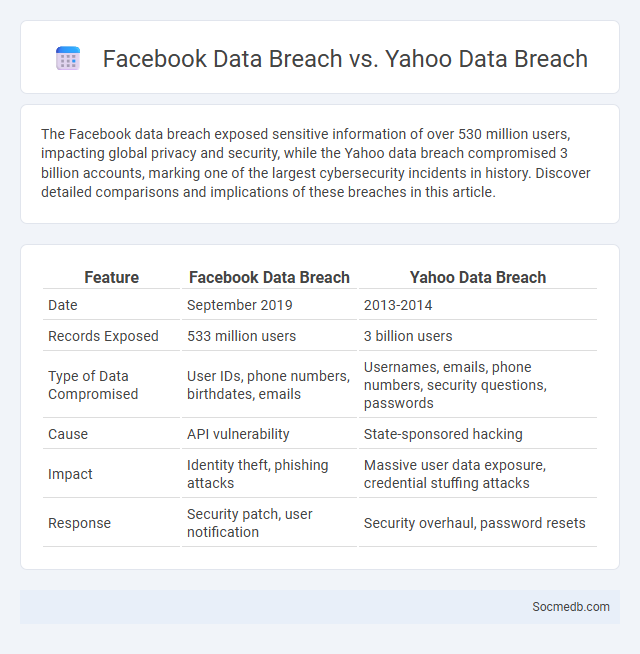
Photo illustration: Facebook Data Breach vs Yahoo Data Breach
The Facebook data breach exposed sensitive information of over 530 million users, impacting global privacy and security, while the Yahoo data breach compromised 3 billion accounts, marking one of the largest cybersecurity incidents in history. Discover detailed comparisons and implications of these breaches in this article.
Table of Comparison
| Feature | Facebook Data Breach | Yahoo Data Breach |
|---|---|---|
| Date | September 2019 | 2013-2014 |
| Records Exposed | 533 million users | 3 billion users |
| Type of Data Compromised | User IDs, phone numbers, birthdates, emails | Usernames, emails, phone numbers, security questions, passwords |
| Cause | API vulnerability | State-sponsored hacking |
| Impact | Identity theft, phishing attacks | Massive user data exposure, credential stuffing attacks |
| Response | Security patch, user notification | Security overhaul, password resets |
Overview: Understanding Data Breaches
Data breaches on social media platforms expose sensitive personal information, risking your privacy and security. Hackers exploit weak passwords and platform vulnerabilities to access user data, leading to identity theft and financial loss. Protecting your social media accounts with strong passwords and two-factor authentication reduces the chances of falling victim to such breaches.
Defining a Data Breach: Key Concepts
A data breach occurs when unauthorized individuals access sensitive or confidential information, compromising your personal or organizational data security. Key concepts include the types of data exposed, such as financial records, login credentials, or private communications, which can lead to identity theft or financial loss. Understanding data breach indicators and implementing preventative measures is essential to protect your digital presence and maintain trust.
Facebook Data Breach: Scope and Impact
The Facebook Data Breach exposed personal information of over 500 million users, including phone numbers, full names, locations, and email addresses, leading to significant privacy concerns and potential identity theft. This massive leak compromised user trust and highlighted vulnerabilities in data security practices within major social media platforms. The breach underscored the critical need for enhanced cybersecurity measures and stricter regulatory oversight in handling user data on Facebook and similar networks.
Yahoo Data Breach: Timeline and Consequences
The Yahoo data breach, which affected over 3 billion accounts between 2013 and 2014, exposed personal information such as email addresses, passwords, and security questions, significantly impacting user privacy and security. Your online identity and social media accounts linked to Yahoo faced increased risks of phishing attacks and identity theft due to the massive scale of compromised data. Understanding this breach's timeline helps you recognize the importance of updating passwords, enabling two-factor authentication, and monitoring accounts for suspicious activity to protect your digital presence.
Facebook vs Yahoo: Major Differences
Facebook emphasizes social networking and interactive content, enabling users to connect through profiles, groups, and messaging, while Yahoo primarily serves as a web portal offering news, email, and search functionalities. Your social media experience on Facebook centers around real-time social engagement and personalized feeds, whereas Yahoo focuses more on content aggregation and information services. The platforms differ fundamentally in their approach, with Facebook prioritizing social interaction and Yahoo focusing on information dissemination.
Common Causes of Data Breaches
Data breaches on social media platforms commonly result from weak password practices, such as reuse and lack of complexity, making accounts vulnerable to unauthorized access. Phishing attacks remain a significant threat, where cybercriminals deceive users into revealing sensitive information, facilitating unauthorized data retrieval. Furthermore, insecure third-party applications and inadequate platform security measures contribute to the exposure of personal and financial data.
User Data Exposed: What’s at Stake?
User data exposed on social media platforms threatens personal privacy, leading to potential identity theft and financial fraud. Hackers exploit vulnerabilities to access sensitive information such as location, contacts, and private messages, increasing the risk of surveillance and targeted cyberattacks. The widespread exposure undermines user trust and raises concerns about data misuse by third parties and advertisers.
Corporate Responses and Legal Fallout
Corporate responses to social media controversies often involve immediate public statements, crisis management teams, and strategic content removal to protect brand reputation. Legal fallout can include defamation lawsuits, regulatory fines, and compliance investigations that impact corporate governance and financial stability. Your company must proactively monitor social media channels and implement clear policies to mitigate risks associated with online reputation and legal challenges.
Protecting Against Future Data Breaches
Protecting against future data breaches on social media requires implementing multi-factor authentication, robust encryption protocols, and regular security audits to safeguard user data. Leveraging AI-driven threat detection systems can identify and mitigate vulnerabilities before exploitation. Prioritizing user privacy settings and educating users on phishing risks further reduces exposure to unauthorized data access.
Lessons Learned from High-Profile Data Breaches
High-profile data breaches on social media platforms reveal critical lessons about cybersecurity vulnerabilities and the importance of robust data protection measures. You must prioritize strong authentication protocols and regularly update privacy settings to safeguard personal information. Understanding these breaches highlights the need for continuous vigilance and education on safe social media practices.
 socmedb.com
socmedb.com